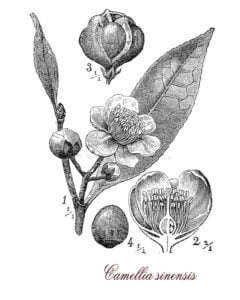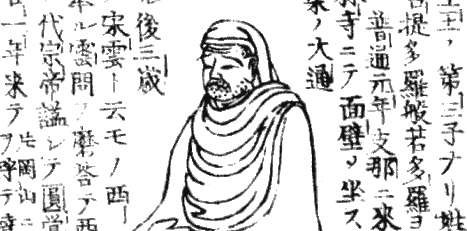The discovery of tea, Camellia sinensis, was ever a story of many dimensions, and the telling of the tale depended on the leaf’s use as medicine, food, or drink. Due to the stimulant effects it was intimately related to deities, demi gods, and mortals.
Actually, it makes sense from a scientific point of view. Most people living in ancient times searched for food to survive and for medicine when they were sick.
In this Article

In fact, the presence of a unique amino acid in tea, L-Theanine can affect aspects of brain function in humans, relaxing the mind without bringing on drowsiness. Further research has indicated that the combination of L- Theanine and caffeine (Tea contains more caffeine than coffee by dry weight), can improve speed, performance and accuracy in cognitively demanding tasks – the cognitive performance is improved and it can promote alpha wave production in the brain.
Bodhidharma

Bodhidharma, Chinese: Ta Mo; Japanese: Daruma 達摩, his name means “dharma of awakening (bodhi)” in Sanskrit. He was a Buddhist monk who traveled from India to China during the 5th or 6th century. According to Chinese sources, some thirty five years earlier, he was born a Brahman of the Hindu faith and a prince of the southern Indian kingdom of Pallava, Kanchipuram. This is consistent with the Southeast Asian traditions which also describe Bodhidharma as a former South Indian Tamil prince who had awakened his kundalini and renounced royal life to become a monk. The Tibetan version similarly characterises him as a dark-skinned siddha from South India. Conversely, the Japanese tradition generally regards Bodhidharma as Persian.
He converted to Buddhism in his youth and was instructed by his teacher to go to China and Japan.
He is traditionally credited as the transmitter of Zen or Chan Buddhism to China, and is regarded as its first Chinese patriarch. According to a 17th-century apocryphal story found in a manual called Yijin Jing, he began the physical training of the monks of Shaolin Monastery that led to the creation of Shaolin kungfu. He is known as Dá Mó in China and as Daruma in Japan.
Bodhidharma legendary bought tea to India:
How Tea came to India
Bodhidharma took the vow not to sleep for 7 years around 500 CE After 5 years of mental immersion it appeared that he could no longer fight the need to sleep.
Knowing he would not be able to keep his vow, in despair, he grasped a couple of branches of the tree where he had made his camp.
He put a few leaves into his mouth and chewed them. Immediately, Dharma experienced a refreshing and invigorating effect, his tiredness evaporated and he could keep his vow.

Skin – flesh – bone – marrow
Jingde Records of the Transmission of the Lamp (景德传灯录) of Daoyuan, presented to the emperor in 1004, records that Bodhidharma wished to return to India and called together his disciples:
Bodhidharma asked, “Can each of you say something to demonstrate your understanding?”
Dao Fu stepped forward and said, “It is not bound by words and phrases, nor is it separate from words and phrases. This is the function of the Tao.”
Bodhidharma: “You have attained my skin.”
The nun Zong Chi stepped up and said, “It is like a glorious glimpse of the realm of Akshobhya Buddha. Seen once, it need not be seen again.”
Bodhidharma; “You have attained my flesh.”
Dao Yu said, “The four elements are all empty. The five skandhas are without actual existence. Not a single dharma can be grasped.”
Bodhidharma: “You have attained my bones.”
Finally, Huike came forth, bowed deeply in silence and stood up straight.
Bodhidharma said, “You have attained my marrow.”
Bodhidharma passed on the symbolic robe and bowl of dharma succession to Dazu Huike and, some texts claim, a copy of the Laṅkāvatāra Sūtra. Bodhidharma then either returned to India or died.
~ ○ ~
Keep exploring:
Works Cited & Multimedia Sources
- Daruma as depicted in the Butsuzō-zu-i 仏像図彙, Collected Illustrations of Buddhist Images. Published in 1690 (Genroku 元禄 3).
- Dumoulin Heinrich. Zen Buddhism: A History. 1988.
- Harbowy M. & Balentine D..Tea chemistry. Critical Reviews in Plant Sciences. 1997.
- Porter Bill. The Zen Teaching of Bodhidharma. 1987.
- Wikimedia Commons: formula of L-theanine, by Benrr101 (Own work).
- https://en.wikipedia.org/wiki/Bodhidharma
- Ferguson, Andrew, Zen’s Chinese Heritage: The Masters and their Teachings, Somerville: Wisdom Publications. 2000.



